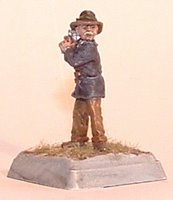6. If humans descended from monkeys, why are there still monkeys?
This surprisingly common argument reflects several levels of ignorance about evolution. The first mistake is that evolution does not teach that humans descended from monkeys; it states that both have a common ancestor.
The deeper error is that this objection is tantamount to asking, "If children descended from adults, why are there still adults?" New species evolve by splintering off from established ones, when populations of organisms become isolated from the main branch of their family and acquire sufficient differences to remain forever distinct. The parent species may survive indefinitely thereafter, or it may become extinct.
8. Mathematically, it is inconceivable that anything as complex as a protein, let alone a living cell or a human, could spring up by chance.
This explanation is good, but leaves out a key element--the vast amount of time over which natural selection has in which to work. Similarly to the vastness of space, the vastness of time is something we all have trouble wrapping our minds around. We can look at the numbers in scientific notiation, even read examples and comparisons, but at the end of the day time and space are too vast for us to really take their measure in a way we can internalize.
Chance plays a part in evolution (for example, in the random mutations that can give rise to new traits), but evolution does not depend on chance to create organisms, proteins or other entities. Quite the opposite: natural selection, the principal known mechanism of evolution, harnesses nonrandom change by preserving "desirable" (adaptive) features and eliminating "undesirable" (nonadaptive) ones. As long as the forces of selection stay constant, natural selection can push evolution in one direction and produce sophisticated structures in surprisingly short times. As an analogy, consider the 13-letter sequence "TOBEORNOTTOBE." Those hypothetical million monkeys, each pecking out one phrase a second, could take as long as 78,800 years to find it among the 2613 sequences of that length. But in the 1980s Richard Hardison of Glendale College wrote a computer program that generated phrases randomly while preserving the positions of individual letters that happened to be correctly placed (in effect, selecting for phrases more like Hamlet's). On average, the program re-created the phrase in just 336 iterations, less than 90 seconds. Even more amazing, it could reconstruct Shakespeare's entire play in just four and a half days.
11. Natural selection might explain microevolution, but it cannot explain the origin of new species and higher orders of life.
Evolutionary biologists have written extensively about how natural selection could produce new species. For instance, in the model called allopatry, developed by Ernst Mayr of Harvard University, if a population of organisms were isolated from the rest of its species by geographical boundaries, it might be subjected to different selective pressures. Changes would accumulate in the isolated population. If those changes became so significant that the splinter group could not or routinely would not breed with the original stock, then the splinter group would be reproductively isolated and on its way toward becoming a new species. Natural selection is the best studied of the evolutionary mechanisms, but biologists are open to other possibilities as well. Biologists are constantly assessing the potential of unusual genetic mechanisms for causing speciation or for producing complex features in organisms. Lynn Margulis of the University of Massachusetts at Amherst and others have persuasively argued that some cellular organelles, such as the energy-generating mitochondria, evolved through the symbiotic merger of ancient organisms. Thus, science welcomes the possibility of evolution resulting from forces beyond natural selection. Yet those forces must be natural; they cannot be attributed to the actions of mysterious creative intelligences whose existence, in scientific terms, is unproved.
14. Living things have fantastically intricate features--at the anatomical, cellular and molecular levels--that could not function if they were any less complex or sophisticated. The only prudent conclusion is that they are the products of intelligent design, not evolution.
This "argument from design" is the backbone of most recent attacks on evolution, but it is also one of the oldest. In 1802 theologian William Paley wrote that if one finds a pocket watch in a field, the most reasonable conclusion is that someone dropped it, not that natural forces created it there. By analogy, Paley argued, the complex structures of living things must be the handiwork of direct, divine invention. Darwin wrote On the Origin of Species as an answer to Paley: he explained how natural forces of selection, acting on inherited features, could gradually shape the evolution of ornate organic structures.
Generations of creationists have tried to counter Darwin by citing the example of the eye as a structure that could not have evolved. The eye's ability to provide vision depends on the perfect arrangement of its parts, these critics say. Natural selection could thus never favor the transitional forms needed during the eye's evolution--what good is half an eye? Anticipating this criticism, Darwin suggested that even "incomplete" eyes might confer benefits (such as helping creatures orient toward light) and thereby survive for further evolutionary refinement. Biology has vindicated Darwin: researchers have identified primitive eyes and light-sensing organs throughout the animal kingdom and have even tracked the evolutionary history of eyes through comparative genetics. (It now appears that in various families of organisms, eyes have evolved independently.)
Today's intelligent-design advocates are more sophisticated than their predecessors, but their arguments and goals are not fundamentally different. They criticize evolution by trying to demonstrate that it could not account for life as we know it and then insist that the only tenable alternative is that life was designed by an unidentified intelligence.












